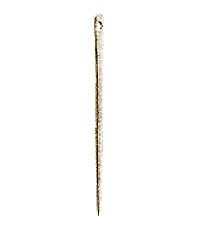The Sword and Shield
Throughout history, In order to sew a seam, the very basic tools needed are a needle, thimble and thread. While the need to sew all seams by hand has remarkably decreased with the sewing machine available as a power tool allowing much more speed in constructing garments, the need for sewing by hand has not been eliminated. You might want to use hand sewing if you are interested in period correct historic costume or couture construction.
 |
As the finer steel needle developed and was available into the reign of Queen Elizabeth from the metalsmiths of the Middle East, needlework became even more elaborate and detailed.
The needles developed then and are now needles we still use today-- Sharps are what we use most often in our households; Straws, or Milliner's needles were often used to make straw hats, thicker blunter needles called Blunts, used for skill-building young women in embroidery and by tailors and cobblers to sew with leather and heavy fabrics.
 |
| click to enlarge |
Needles today are available in 24 sizes. The higher the number, the smaller the needle.
Thimbles were also developed in the earliest centuries. The Art of Sewing Volume 1 shows a picture of a bronze thimble found in Syria dated to 300 BC. The correct way to wear a thimble is on your middle finger of your needle or sewing hand. I'm left-handed so it would go on my left second finger. Your thimble should be lightweight and have deep enough ridges that your needle will not slip. The use of the thimble is to push the needle through the fabric using the side of the thimble, not the tip. There are a variety of thimble types available.


Your blog is truly fantastic. Many thanks for the concise and precise instructions. Plus I love the historical aspect of it all.
ReplyDeleteOh thank you! If there is anything you would like me to expand upon, please let me know! I hope you continue to visit and gain some value. I feel like these sewing books have so much to offer but they likely languish unopened to decorate shelves. Sometimes opened but to look at the period graphics (which for photographers and graphic artists must be interesting).
ReplyDelete